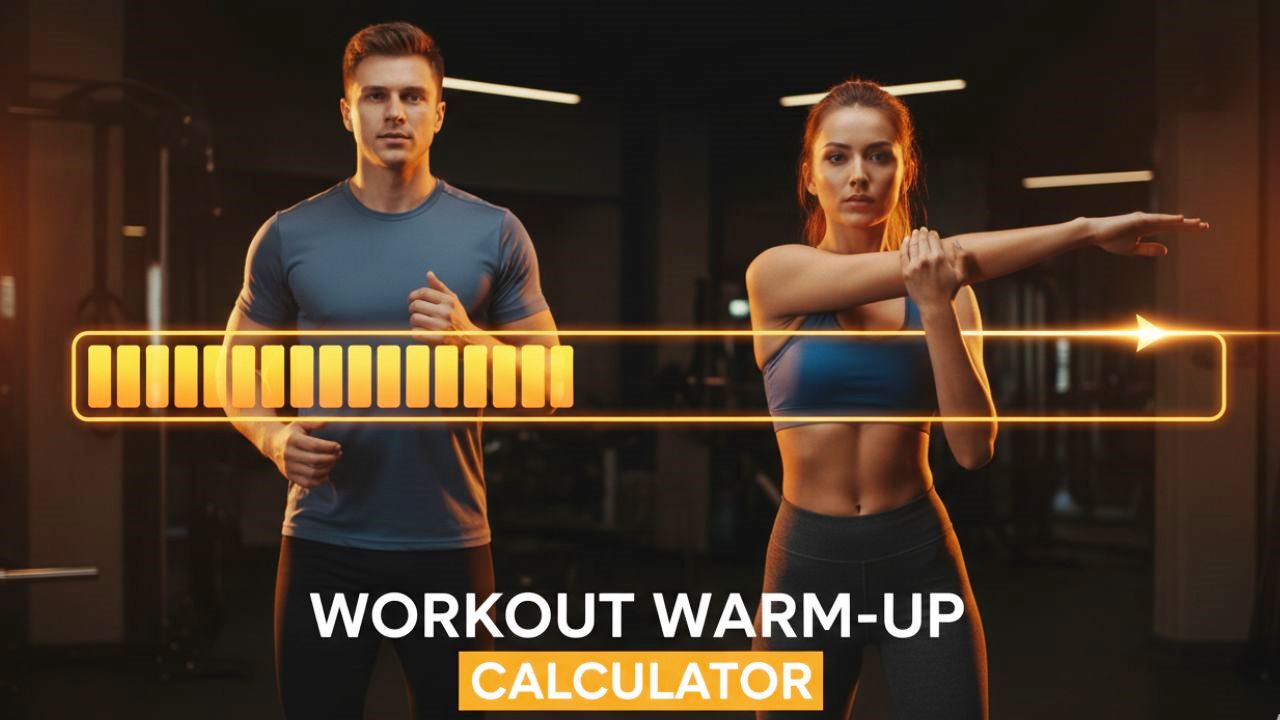Warmup Calculator
Generate personalized warmup routines based on your exercise type and fitness level

What Makes a Good Warmup?
A proper warmup prepares your body for exercise by gradually increasing blood flow, raising muscle temperature, and improving joint mobility. Research shows that well-designed warmup routines can reduce injury risk by 11-20% while improving performance by 3-10%.
The key is to start slow and build up intensity. This helps your body transition from rest to exercise safely and effectively.
Three-Phase Warmup Structure
Effective warmups follow a three-phase approach that systematically prepares your body for different types of exercise.
Phase 1: General Movement (20-25%)
Start with gentle movements to increase blood flow and joint mobility. This phase raises your core body temperature by 1-3°C and prepares your nervous system for activity.
Phase 2: Dynamic Activation (35-40%)
Move into exercise-specific movements that activate the muscles you’ll use. This phase improves coordination and prepares your body for the specific demands of your workout.
Phase 3: Specific Preparation (35-40%)
Practice the actual movements you’ll do in your workout at gradually increasing intensity. This phase ensures your body is fully prepared for the demands ahead.
How Long Should You Warm Up?
Warmup duration depends on several factors. As a general rule, plan for 10-15% of your total exercise time, with a minimum of 8 minutes and maximum of 25 minutes.
• Session: +5 min (90+ min workout)
• Intensity: +2-6 min (light to maximal)
• Fitness: +3 min (beginner) to -1 min (elite)
• Environment: +5 min (cold) to -2 min (hot)
• Time: +4 min (morning) to 0 min (afternoon)
For example, a beginner doing a 60-minute moderate-intensity workout in cool morning conditions would need about 18-20 minutes of warmup time.
Exercise-Specific Warmup Guidelines
Different types of exercise require different warmup approaches. Here’s how to customize your routine:
Environmental Factors
Environmental conditions significantly impact your warmup needs. Cold weather requires longer warmups to achieve optimal muscle temperature, while hot conditions may need shorter warmups but more attention to hydration.
Cold Weather (<15°C)
Add 3-5 minutes to your warmup. Focus on gradual movements and layer clothing to maintain body heat.
Hot Weather (>30°C)
Reduce warmup by 1-2 minutes but stay well hydrated. Avoid overheating during the warmup phase.
Time of Day
Morning workouts need longer warmups due to lower body temperature. Evening sessions can be shorter as your body is already warmer.
Injury Prevention Benefits
Proper warmups are your first line of defense against exercise-related injuries. They prepare your body in multiple ways:
- Tissue Preparation: Gradual temperature increase makes muscles and tendons more elastic, reducing strain risk during sudden movements.
- Joint Mobility: Dynamic movements increase synovial fluid production and improve joint range of motion.
- Neural Activation: Progressive movements enhance motor unit recruitment and coordination, improving movement quality.
- Cardiovascular Preparation: Gradual heart rate elevation prevents sudden cardiovascular stress and ensures adequate blood flow.
- Mental Preparation: Warmup time allows for mental focus and visualization, reducing anxiety and improving performance.
Studies confirm that athletes who follow structured warmup protocols experience significantly fewer injuries, especially in high-impact activities like running and team sports.
⚕️ Important Safety Notes
This warmup calculator provides general guidelines based on scientific research. Individual needs may vary based on age, health conditions, medications, and other factors. Always listen to your body and consult with a healthcare provider if you have any health concerns or pre-existing conditions before starting a new exercise program.
References
- Ribeiro B, Pereira A, Neves PP, Sousa AC, Ferraz R, Marques MC, Marinho DA, Neiva HP. The Role of Specific Warm-up during Bench Press and Squat Exercises: A Novel Approach. Int J Environ Res Public Health. 2020 Sep 22;17(18):6882. doi: 10.3390/ijerph17186882. PMID: 32971729; PMCID: PMC7558980.
- Souza D, Silva AG, Vale A, Pessoni A, Galvão L, Araújo MA, de Paula Júnior C, Vieira C, Vieira A, Gentil P. Effect of warm-up protocols using lower and higher loads on multiple-set back squat volume-load. PeerJ. 2024 Jul 9;12:e17347. doi: 10.7717/peerj.17347. PMID: 39006036; PMCID: PMC11243969.
- Mcgowan, Courtney & Pyne, David & Thompson, Kevin & Rattray, Ben. (2015). Warm-Up Strategies for Sport and Exercise: Mechanisms and Applications. Sports medicine (Auckland, N.Z.). 45. 10.1007/s40279-015-0376-x.
